Flower design is the art of arranging flowers in a pleasing and aesthetically pleasing way. It can be used to create arrangements for a variety of occasions, such as weddings, funerals, holidays, and special events. Flower designers use a variety of techniques and principles to create their arrangements, such as color theory, balance, and scale.
The elements of flower design
There are a number of different elements that go into flower design, including:
- Flowers: The type of flowers used in an arrangement can have a big impact on its overall look and feel. Different flowers have different colors, textures, and shapes, and flower designers carefully consider these factors when choosing flowers for an arrangement.
- Foliage: Foliage is the green part of a plant, and it can be used to add interest and texture to flower arrangements. Foliage can also be used to create a frame for the flowers or to fill in any gaps in the arrangement.
- Vases and containers: The vase or container that is used to hold a flower arrangement can also play a role in its overall design. Vases and containers come in a variety of shapes, sizes, and colors, and flower designers choose them to complement the flowers and foliage in the arrangement.
- Accessories: Accessories, such as ribbons, bows, and wire, can be used to add a finishing touch to flower arrangements. Accessories can also be used to create specific effects, such as a cascading arrangement or a topiary.
The principles of flower design
In addition to the elements of flower design, there are also a number of principles that flower designers follow when creating their arrangements. These principles include:
- Balance: Balance refers to the way that the weight of the flowers and foliage in an arrangement is distributed. A balanced arrangement will be visually pleasing and will not look like it is going to tip over.
- Color theory: Color theory is the study of how colors interact with each other. Flower designers use color theory to create arrangements that are visually appealing and harmonious.
- Scale: Scale refers to the size of the flowers and foliage in an arrangement relative to each other. Flower designers use scale to create arrangements that are visually balanced and proportional.
- Unity: Unity refers to the way that all of the elements in a flower arrangement work together to create a cohesive whole. Flower designers carefully consider all of the elements of an arrangement when creating it to ensure that it has a unified look.
Types of flower arrangements
There are many different types of flower arrangements, each with its own unique style and design. Some of the most common types of flower arrangements include:
- Bouquets: Bouquets are handheld arrangements of flowers and foliage. They are often given as gifts for special occasions, such as birthdays, anniversaries, and weddings.
- Centerpieces: Centerpieces are arrangements of flowers and foliage that are placed on tables or other surfaces at events. They are often used to decorate tables at weddings, parties, and other special occasions.
- Corsages and boutonnieres: Corsages and boutonnieres are small flower arrangements that are worn on clothing. Corsages are typically worn by women, while boutonnieres are typically worn by men. They are often worn to formal events, such as weddings and proms.
- Wreaths and garlands: Wreaths and garlands are circular arrangements of flowers and foliage that are often used to decorate doors, windows, and other surfaces during the holidays.
Flower design tips
Here are a few tips for creating beautiful flower arrangements:
- Choose fresh flowers: Fresh flowers will look their best and last longer than wilted flowers.
- Use a variety of flowers and foliage: This will create a more interesting and visually appealing arrangement.
- Consider the color scheme: Choose flowers and foliage that complement each other in terms of color.
- Pay attention to balance and scale: Create an arrangement that is visually balanced and proportional.
- Add accessories to finish the look: Ribbons, bows, and wire can add a finishing touch to your arrangement.

